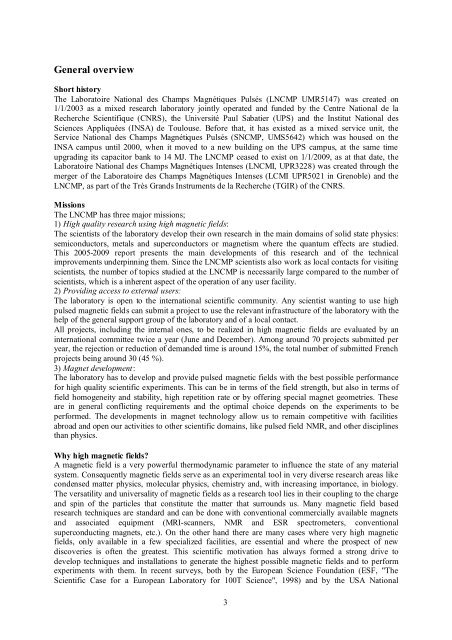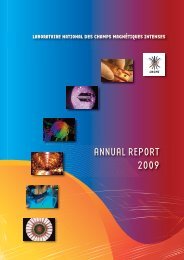Laboratoire National des Champs Magnétiques Pulsés CNRS – INSA
Laboratoire National des Champs Magnétiques Pulsés CNRS – INSA
Laboratoire National des Champs Magnétiques Pulsés CNRS – INSA
You also want an ePaper? Increase the reach of your titles
YUMPU automatically turns print PDFs into web optimized ePapers that Google loves.
General overview<br />
Short history<br />
The <strong>Laboratoire</strong> <strong>National</strong> <strong>des</strong> <strong>Champs</strong> <strong>Magnétiques</strong> <strong>Pulsés</strong> (LNCMP UMR5147) was created on<br />
1/1/2003 as a mixed research laboratory jointly operated and funded by the Centre <strong>National</strong> de la<br />
Recherche Scientifique (<strong>CNRS</strong>), the Université Paul Sabatier (UPS) and the Institut <strong>National</strong> <strong>des</strong><br />
Sciences Appliquées (<strong>INSA</strong>) de Toulouse. Before that, it has existed as a mixed service unit, the<br />
Service <strong>National</strong> <strong>des</strong> <strong>Champs</strong> <strong>Magnétiques</strong> <strong>Pulsés</strong> (SNCMP, UMS5642) which was housed on the<br />
<strong>INSA</strong> campus until 2000, when it moved to a new building on the UPS campus, at the same time<br />
upgrading its capacitor bank to 14 MJ. The LNCMP ceased to exist on 1/1/2009, as at that date, the<br />
<strong>Laboratoire</strong> <strong>National</strong> <strong>des</strong> <strong>Champs</strong> <strong>Magnétiques</strong> Intenses (LNCMI, UPR3228) was created through the<br />
merger of the <strong>Laboratoire</strong> <strong>des</strong> <strong>Champs</strong> <strong>Magnétiques</strong> Intenses (LCMI UPR5021 in Grenoble) and the<br />
LNCMP, as part of the Très Grands Instruments de la Recherche (TGIR) of the <strong>CNRS</strong>.<br />
Missions<br />
The LNCMP has three major missions;<br />
1) High quality research using high magnetic fields:<br />
The scientists of the laboratory develop their own research in the main domains of solid state physics:<br />
semiconductors, metals and superconductors or magnetism where the quantum effects are studied.<br />
This 2005-2009 report presents the main developments of this research and of the technical<br />
improvements underpinning them. Since the LNCMP scientists also work as local contacts for visiting<br />
scientists, the number of topics studied at the LNCMP is necessarily large compared to the number of<br />
scientists, which is a inherent aspect of the operation of any user facility.<br />
2) Providing access to external users:<br />
The laboratory is open to the international scientific community. Any scientist wanting to use high<br />
pulsed magnetic fields can submit a project to use the relevant infrastructure of the laboratory with the<br />
help of the general support group of the laboratory and of a local contact.<br />
All projects, including the internal ones, to be realized in high magnetic fields are evaluated by an<br />
international committee twice a year (June and December). Among around 70 projects submitted per<br />
year, the rejection or reduction of demanded time is around 15%, the total number of submitted French<br />
projects being around 30 (45 %).<br />
3) Magnet development:<br />
The laboratory has to develop and provide pulsed magnetic fields with the best possible performance<br />
for high quality scientific experiments. This can be in terms of the field strength, but also in terms of<br />
field homogeneity and stability, high repetition rate or by offering special magnet geometries. These<br />
are in general conflicting requirements and the optimal choice depends on the experiments to be<br />
performed. The developments in magnet technology allow us to remain competitive with facilities<br />
abroad and open our activities to other scientific domains, like pulsed field NMR, and other disciplines<br />
than physics.<br />
Why high magnetic fields?<br />
A magnetic field is a very powerful thermodynamic parameter to influence the state of any material<br />
system. Consequently magnetic fields serve as an experimental tool in very diverse research areas like<br />
condensed matter physics, molecular physics, chemistry and, with increasing importance, in biology.<br />
The versatility and universality of magnetic fields as a research tool lies in their coupling to the charge<br />
and spin of the particles that constitute the matter that surrounds us. Many magnetic field based<br />
research techniques are standard and can be done with conventional commercially available magnets<br />
and associated equipment (MRI-scanners, NMR and ESR spectrometers, conventional<br />
superconducting magnets, etc.). On the other hand there are many cases where very high magnetic<br />
fields, only available in a few specialized facilities, are essential and where the prospect of new<br />
discoveries is often the greatest. This scientific motivation has always formed a strong drive to<br />
develop techniques and installations to generate the highest possible magnetic fields and to perform<br />
experiments with them. In recent surveys, both by the European Science Foundation (ESF, "The<br />
Scientific Case for a European Laboratory for 100T Science", 1998) and by the USA <strong>National</strong><br />
3







